Super-resolution imaging breaks the diffraction barrier that limits traditional microscopes to 200nm resolution. Techniques like STORM, PALM, and STED manipulate fluorescent molecules to capture details as small as 20nm. These methods activate specific fluorophores at different times, recording their precise coordinates to build remarkably clear cell images. The enhanced clarity reveals subcellular structures and dynamic processes that were previously invisible. Discover how these revolutionary techniques transform blurry images into crystal-clear visualizations of cellular life.
Numeric List of Second-Level Headings
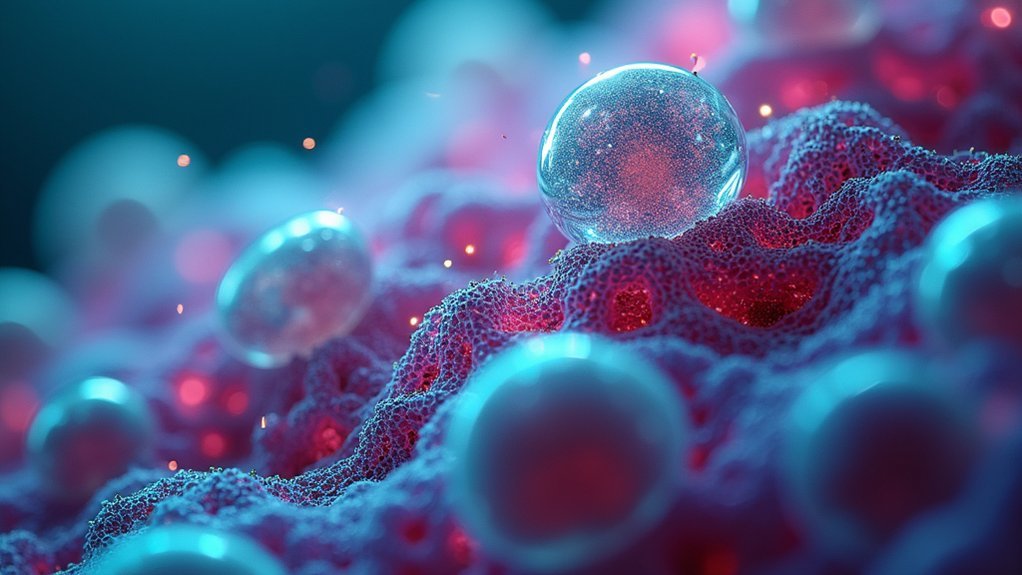
Four essential sections form the foundation of our super-resolution imaging discussion.
- Breaking the Diffraction Barrier: Learn how STORM, PALM, and STED techniques overcome light’s natural limitations to reveal details at 20 nm resolution or better.
- Fluorescent Dyes and Single-Molecule Tracking: Discover how optimized fluorophores enhance contrast while reducing phototoxicity and photobleaching compared to traditional methods.
- Visualizing Dynamic Cellular Processes: Explore how super-resolution microscopy captures real-time molecular interactions, revealing previously invisible biological mechanisms.
- Optical Fingerprinting of Cell Structures: Understand how advanced differentiation techniques help you distinguish between various organelles and subcellular components with unprecedented clarity.
Each section demonstrates why super-resolution microscopy delivers dramatically clearer cell photos than conventional imaging, giving you access to cellular details that were once impossible to visualize.
Breaking the Diffraction Barrier: How Super-Resolution Works
You’ve probably heard that light microscopes can’t see objects closer than 200 nanometers apart—a frustrating barrier called the diffraction limit.
Scientists have developed ingenious workarounds like STORM, PALM, and STED that manipulate the behavior of fluorescent molecules rather than trying to overcome physics directly.
These techniques fundamentally turn fluorophores on and off in controlled patterns, allowing researchers to pinpoint molecules with incredible precision and construct images showing cellular structures at resolutions as fine as 20 nanometers.
Light’s Fundamental Limit
For over a century, scientists were constrained by what seemed an insurmountable barrier in microscopy—the diffraction limit of light. You couldn’t see details smaller than approximately 200-250 nm regardless of microscope quality, leaving cell structures blurry and indistinct.
This fundamental physical limit occurs because:
- Light waves diffract (spread out) when passing through small apertures
- Closely positioned molecules appear as a single blurred spot
- Conventional microscopes can’t distinguish objects closer than half the wavelength of light
- Cell organelles and molecular machinery often exist at scales below this limit
- Without super-resolution microscopy, many critical cellular processes remained invisible
This limitation frustrated researchers until recently, when innovative high-resolution techniques emerged to bypass—rather than break—physics itself, revealing cellular worlds previously hidden from scientific observation.
Nanoscale Imaging Tricks
What once seemed an insurmountable physical boundary has now been elegantly circumvented through ingenious molecular manipulation.
Super-resolution fluorescence microscopy techniques like STORM, PALM, and STED break the diffraction limit by localizing individual fluorescent molecules with astonishing precision.
You’ll find these methods achieve resolutions down to 20 nm—a remarkable 2-10 times clearer than conventional microscopy. The secret lies in controlled activation and deactivation of fluorophores, allowing researchers to map molecular positions with unprecedented accuracy.
What makes this revolutionary for cell biology is the ability to observe subcellular structures in live cells without extensive sample preparation.
Though creating a single detailed image requires processing thousands of frames, the reward is transformative: you can now witness dynamic cellular processes in real-time at nanoscale resolution previously thought impossible.
From Blurry to Brilliant: The Physics Behind Enhanced Cellular Imaging
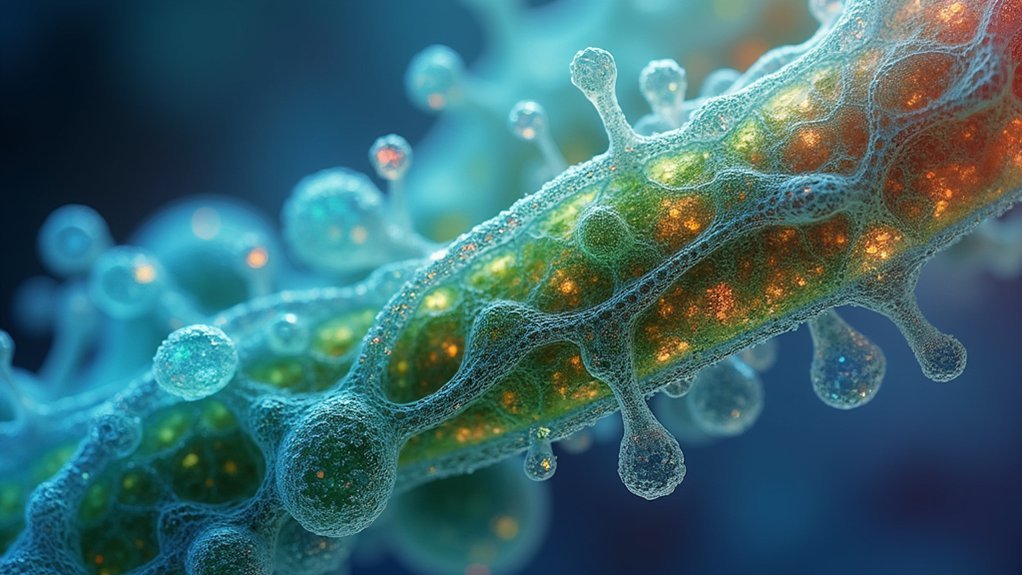
While traditional microscopy has long been stymied by the diffraction limit, today’s super-resolution techniques are revolutionizing how we visualize cellular structures.
Super-resolution images overcome these physical barriers through innovative physics applications that enhance clarity and detail.
Here’s how these technologies transform blurry images into brilliant visualizations:
- Stimulated emission depletion (STED) uses dual lasers to selectively deactivate fluorophores, greatly sharpening images
- Structured illumination microscopy (SIM) creates Moiré patterns with patterned light to achieve ~100 nm resolution
- STORM and PALM techniques localize individual molecules with precision down to 20 nm
- Advanced fluorescent dyes enable simultaneous multi-color imaging of different cellular structures
- Improved quantum efficiency and sophisticated data processing reduce noise and enhance image contrast
You’re now witnessing cellular details previously invisible to scientists, opening new frontiers in biological understanding.
STORM, PALM, and GSDIM: Single-Molecule Localization Techniques Explained
You’ll notice dramatic differences in precision when comparing STORM, PALM, and GSDIM techniques, each employing unique fluorophore activation mechanisms to visualize individual molecules.
STORM uses switchable fluorophore pairs, PALM employs genetically encoded photoactivatable markers, and GSDIM manipulates the triplet state to keep molecules dark until imaging.
These approaches smash through traditional resolution limits, allowing you to see cellular structures as small as 20-30 nm—far beyond what conventional microscopy can achieve.
Molecule Precision Comparison
The breakthrough domain of single-molecule localization microscopy has revolutionized how we observe cellular structures at the nanoscale.
When you’re comparing STORM, PALM, and GSDIM techniques, you’ll find they differ in precision and application despite sharing the fundamental goal of super-resolution imaging.
- STORM achieves high spatial resolution through fluorophore pairs, making it ideal for complex multi-color imaging.
- PALM offers exceptional protein-specific visualization using genetically encoded markers.
- GSDIM provides enhanced single molecule localization by utilizing the triplet state of fluorophores.
- All three techniques can achieve remarkable 20 nm resolution, far surpassing conventional microscopy.
Your choice between these super-resolution microscopes should depend on your specific cellular structures of interest and available fluorescent probes.
Fluorophore Activation Mechanisms
Understanding how each super-resolution technique activates its fluorophores reveals why these methods can break through diffraction barriers that once limited microscopy.
In STORM imaging, specific activator light triggers reporter dyes, allowing you to locate individual molecules with precision below 20 nm.
PALM works differently by using genetically encoded, photoactivatable fluorophores—specialized fluorescent proteins that switch on and off with light exposure. This enables high-precision mapping of cellular structures at the nanoscale.
GSDIM maintains fluorophores in a dark “triplet” state until imaging time, enhancing speed while maintaining resolution.
These super-resolution imaging techniques precisely record coordinates of each activated fluorophore, building images far beyond conventional limits.
You’ll witness dynamic cellular processes in real time as these mechanisms reveal molecular interactions previously invisible to researchers.
Resolution Limits Overcome
While conventional microscopy remains limited by the diffraction barrier of approximately 200 nm, single-molecule localization techniques have shattered this boundary by pinpointing individual fluorophores with remarkable precision.
These super-resolution imaging methods achieve resolutions down to 20 nm or less, revealing cellular structures previously invisible to researchers.
- STORM (Stochastic Optical Reconstruction Microscopy) uses activator-reporter fluorophore pairs for precise molecular localization
- PALM employs genetically encoded, photoactivatable fluorophores for visualizing specific proteins
- GSDIM maintains fluorophores in a dark “triplet” state until imaging
All three techniques require specialized conditions and sophisticated image processing.
The enhanced resolution allows unprecedented visualization of subcellular organization and molecular interactions.
You’ll now be able to quantify and analyze biological processes at scales previously thought impossible, revolutionizing our understanding of cellular architecture and function.
STED Microscopy: Sculpting Light for Nanoscale Visualization
When traditional microscopy reaches its physical limits, STED microscopy steps in to revolutionize cellular imaging at the nanoscale level. You’ll witness structures as small as 50 nm through this super-resolution technique that uses two overlapping lasers—one excites fluorophores while the other strategically deactivates peripheral ones.
| Feature | Traditional Microscopy | STED Microscopy | Improvement Factor |
|---|---|---|---|
| Resolution | ~200-300 nm | ~50 nm | 4-6x |
| Visibility | Blurred details | Sharp boundaries | Significant |
| Live cell compatibility | High | Moderate to high | Variable |
| Molecular specificity | Limited | Precise | Substantial |
| Application scope | General | Complex structures | Expanded |
The Leica TCS STED CW exemplifies this technology, operating on a point-scanning confocal system that “sculpts” light to focus on specific molecules. You’re getting 2-10x better resolution than conventional methods, revealing cellular processes previously hidden from view.
Structured Illumination Microscopy (SIM): Patterns That Reveal Hidden Details
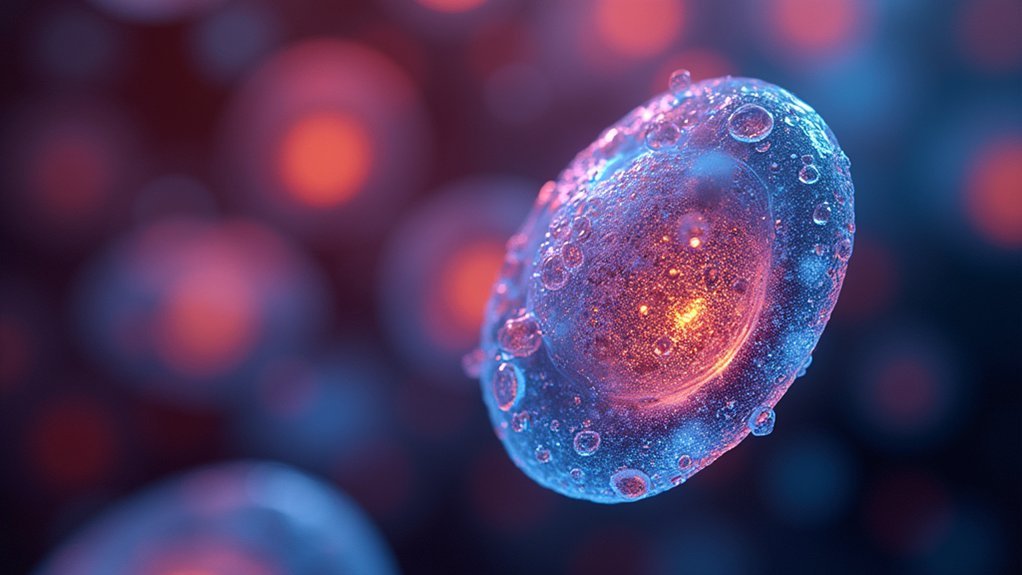
Light patterns reveal cellular secrets invisible to conventional microscopes through Structured Illumination Microscopy (SIM). This super-resolution imaging technique doubles the resolution of traditional confocal microscopy to approximately 100 nm by creating Moiré patterns from multiple orientations and phases of illumination.
- Achieves twice the resolution of conventional microscopy (down to 100 nm)
- Processes Moiré patterns mathematically to reconstruct high-resolution images
- Enables live-cell imaging with super-resolution in about one second
- Works with various fluorescent dyes for 4D imaging (3D plus time)
- Serves as an ideal alternative tool from conventional microscopy
SIM’s compatibility with both fixed and live samples makes it particularly valuable for researchers who need to visualize dynamic cellular structures without specialized sample preparation or extreme light conditions.
AI and Deep Learning: The Computational Revolution in Cell Imaging
Beyond traditional optical innovations, artificial intelligence and deep learning algorithms have transformed super-resolution microscopy into a computational powerhouse.
You’ll find that AI-driven super-resolution imaging processes complex data rapidly, delivering high-resolution reconstructions of subcellular structures in a fraction of the time traditional methods require.
Deep learning models can identify multiple cellular components simultaneously using just a single dye label, cleverly circumventing the multi-color limitations of conventional techniques.
AI-powered imaging revolutionizes single-dye microscopy, distinguishing multiple cellular structures where traditional methods would see only one.
By learning from optical fingerprints unique to different organelles, these algorithms distinguish various subcellular structures with unprecedented precision.
The real game-changer is how AI enables real-time analysis of dynamic cellular processes, allowing you to observe living cells in action rather than just capturing static moments in cellular life.
Multi-Color Imaging Limitations and Super-Resolution Solutions
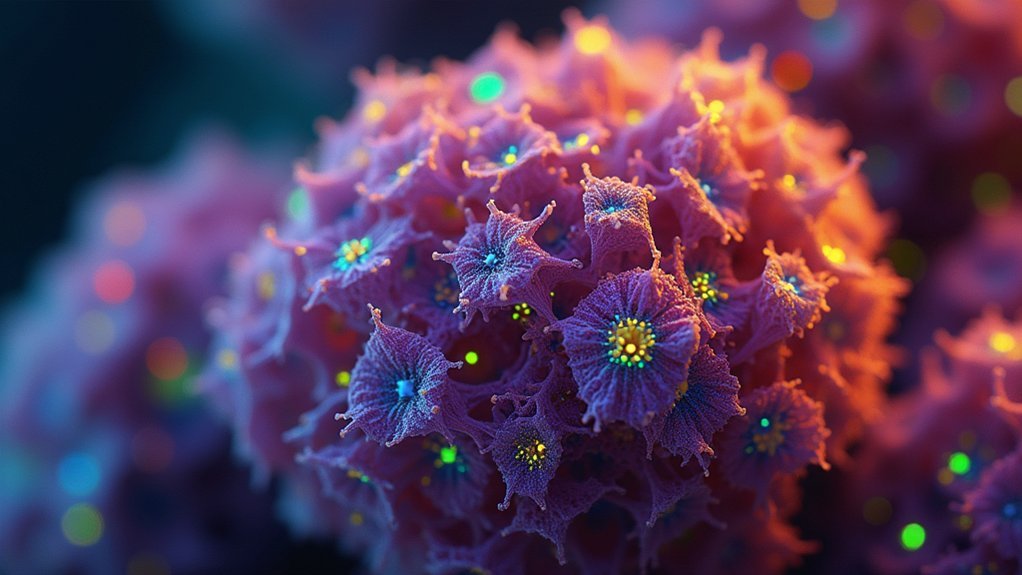
Although traditional fluorescence microscopy has revolutionized our understanding of cellular structures, it continues to struggle with fundamental multi-color imaging constraints.
When you’re analyzing complex cellular components, these limitations considerably impact your research outcomes.
Super-resolution microscopy overcomes these challenges by:
- Utilizing single dye labels to identify up to 15 different subcellular structures simultaneously
- Eliminating the color overlap problems that plague traditional multi-color imaging techniques
- Reducing phototoxicity and photobleaching that damage living cells during observation
- Capturing high-resolution images that serve as unique optical fingerprints of each organelle
- Dramatically speeding up imaging processes while enhancing resolution and clarity
Live Cell Applications: Capturing Dynamic Cellular Processes in Real-Time
While static cell images provide valuable structural information, the true power of super-resolution imaging emerges when you’re tracking dynamic cellular processes as they unfold. Techniques like STORM and PALM achieve remarkable resolution down to 20 nm, enabling you to follow individual molecules as they interact within live cells.
The millisecond timescales of cellular events, such as protein interactions and intracellular transport, demand rapid imaging capabilities. Structured illumination microscopy (SIM) excels here, offering faster acquisition speeds while maintaining compatibility with live cells.
You’ll find these techniques particularly valuable for studying complex processes like cell division and immune responses in their native environments. By utilizing single dye labels, you can visualize multiple cellular components simultaneously without photobleaching complications, giving you unprecedented insights into how cells function in real-time across various tissue types.
Frequently Asked Questions
What Are the Benefits of Super-Resolution Microscopy?
Super-resolution microscopy benefits you by providing 20nm resolution (10x better than traditional methods), allowing you to visualize individual molecules, observe dynamic processes in real-time, use single dye labels, and reduce phototoxicity during imaging.
What Is the Purpose of Super-Resolution?
The purpose of super-resolution is to help you see cellular structures below the diffraction limit of light. You’ll visualize molecules as small as 20 nm, revealing intricate details traditional microscopy can’t capture.
What Are the Disadvantages of Super-Resolution Microscopy?
You’ll find super-resolution microscopy has significant drawbacks: it’s prohibitively expensive ($500,000 average), uses degradable chemical dyes, requires time-consuming processes, causes phototoxicity in live cells, and demands specialized training for operation.
What Is the Principle of Super-Resolution Microscopy?
The principle of super-resolution microscopy is that you’re bypassing light’s diffraction limit by localizing individual fluorescent molecules or using specialized illumination patterns, allowing you’ll see structures smaller than 200 nanometers.
In Summary
You’ve now explored the revolutionary world of super-resolution imaging, where physics, chemistry, and computational power converge to break optical limits once thought impossible. Whether you’re studying membrane dynamics or protein interactions, these techniques let you peer into cellular structures with unprecedented clarity. As both technologies and algorithms continue advancing, you’ll witness even more remarkable capabilities transforming cell biology research before your eyes.

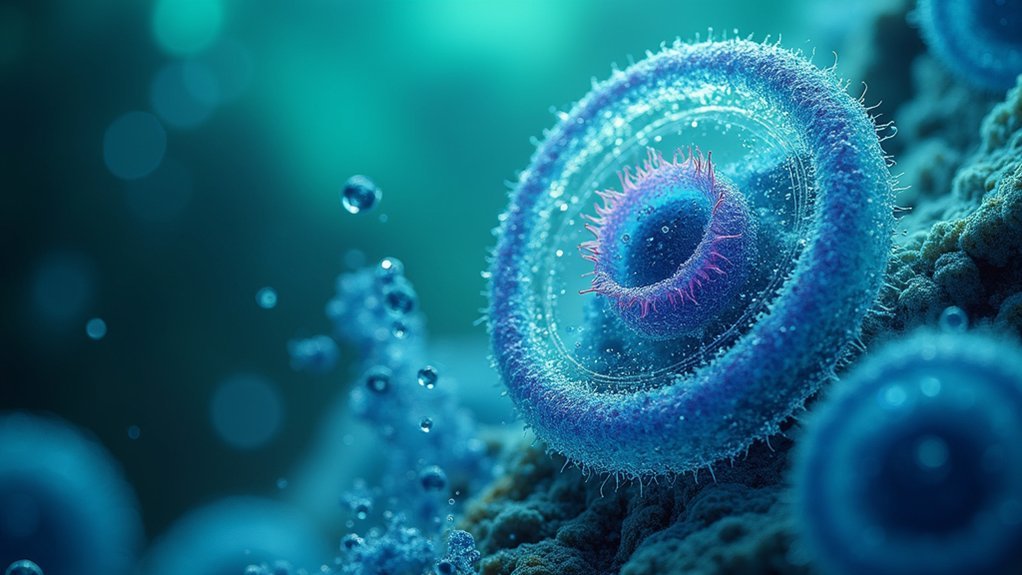



Leave a Reply